Structural Change of TiAl Alloy under Uniaxial Tension and Compression in the <001> Direction: A Molecular Dynamics Study
Abstract
:1. Introduction
2. Computational Methods
3. Results
3.1. Stress-Strain Relation
3.2. Structural Change
3.3. Radial Distribution Function
4. Discussion
5. Conclusions
Supplementary Materials
Author Contributions
Funding
Data Availability Statement
Conflicts of Interest
References
- Li, X.; Lu, L.; Li, J.; Zhang, X.; Gao, H. Mechanical properties and deformation mechanisms of gradient nanostructured metals and alloys. Nat. Rev. Mater. 2020, 5, 706–723. [Google Scholar] [CrossRef]
- Gale, W.F. Mechanical properties of metals and alloys. In Smithells Metals Reference Book; Totemeier, T.C., Ed.; Butterworth-Heinemann: Oxford, UK, 2004. [Google Scholar]
- Dewidar, M.M.; Yoon, H.-C.; Lim, J.K. Mechanical properties of metals for biomedical applications using powder metallurgy process: A review. Met. Mater. Int. 2006, 12, 193. [Google Scholar] [CrossRef]
- Olugbade, T.O.; Lu, J. Literature review on the mechanical properties of materials after surface mechanical attrition treatment (SMAT). Nano Mater. Sci. 2020, 2, 3–31. [Google Scholar] [CrossRef]
- Zhang, L.; Shibuta, Y.; Huang, X.; Lu, C.; Liu, M. Grain boundary induced deformation mechanisms in nanocrystalline Al by molecular dynamics simulation: From interatomic potential perspective. Comput. Mater. Sci. 2019, 156, 421–433. [Google Scholar] [CrossRef] [Green Version]
- Daghfas, O.; Znaidi, A.; Mohamed, A.B.; Nasri, R. Experimental Study on Mechanical Properties of Aluminum Alloys under Uniaxial Tensile Tests. Int. J. Technol. 2017, 8, 662–672. [Google Scholar] [CrossRef]
- Zhao, X.; Li, H.; Chen, T.; Cao, B.; Li, X. Mechanical Properties of Aluminum Alloys under Low-Cycle Fatigue Loading. Materials 2019, 12, 2064. [Google Scholar] [CrossRef] [Green Version]
- Du, Z.; He, Q.; Chen, R.; Liu, F.; Zhang, J.; Yang, F.; Zhao, X.; Cui, X.; Cheng, J. Rolling reduction—Dependent deformation mechanisms and tensile properties in a β titanium alloy. J. Mater. Sci. Technol. 2021. In Press. [Google Scholar] [CrossRef]
- Clemens, H.; Kestler, H. Processing and Applications of Intermetallic γ-TiAl-Based Alloys. Adv. Eng. Mater. 2000, 2, 551–570. [Google Scholar] [CrossRef]
- Bewlay, B.P.; Nag, S.; Suzuki, A.; Weimer, M.J. TiAl alloys in commercial aircraft engines. Mater. High Temp. 2016, 33, 549–559. [Google Scholar] [CrossRef]
- Burtscher, M.; Klein, T.; Lindemann, J.; Lehmann, O.; Fellmann, H.; Güther, V.; Clemens, H.; Mayer, S. An Advanced TiAl Alloy for High-Performance Racing Applications. Materials 2020, 13, 4720. [Google Scholar] [CrossRef]
- Pflumm, R.; Donchev, A.; Mayer, S.; Clemens, H.; Schütze, M. High-temperature oxidation behavior of multi-phase Mo-containing γ-TiAl-based alloys. Intermetallics 2014, 53, 45–55. [Google Scholar] [CrossRef]
- Schwaighofer, E.; Clemens, H.; Mayer, S.; Lindemann, J.; Klose, J.; Smarsly, W.; Güther, V. Microstructural design and mechanical properties of a cast and heat-treated intermetallic multi-phase γ-TiAl based alloy. Intermetallics 2014, 44, 128–140. [Google Scholar] [CrossRef]
- Gebauer, K. Performance, tolerance and cost of TiAl passenger car valves. Intermetallics 2006, 14, 355–360. [Google Scholar] [CrossRef]
- Eylon, D.; Keller, M.; Jones, P. Development of permanent-mold cast TiAl automotive valves. Intermetallics 1998, 6, 703–708. [Google Scholar] [CrossRef]
- Bao, J.-W.; Yang, S.-Y.; Yang, T. Microstructural evolution, tensile property and dynamic compressive property of FSWed Ti–6Al–4V alloy. Rare Met. 2020, 39, 169–175. [Google Scholar] [CrossRef]
- Wan, B.; Li, X.-Q.; Pan, C.-L.; Li, D.-Y.; Qu, S.-G.; Yang, C. Microstructure and mechanical properties of TiAl/Ni-based superalloy joints vacuum brazed with Ti–Zr–Fe–Cu–Ni–Co–Mo filler metal. Rare Met. 2021, 40, 2134–2142. [Google Scholar] [CrossRef]
- Yang, W.; Ayoub, G.; Salehinia, I.; Mansoor, B.; Zbib, H. Multiaxial tension/compression asymmetry of Ti/TiN nano laminates: MD investigation. Acta Mater. 2017, 135, 348–360. [Google Scholar] [CrossRef]
- Zhoua, X.; Fub, H.; Zhua, J.-H.; Yang, X.-S. Atomistic simulations of the surface severe plastic deformation-induced grain refinement in polycrystalline magnesium: The effect of processing parameters. J. Magnes. Alloy. 2021. In Press. [Google Scholar] [CrossRef]
- Zhang, Z.-Q.; Wang, H.-Y.; Wang, L.; Chen, X.-B.; Guan, S.-K.; Lin, C.-G.; Zeng, R.-C. Protein conformation and electric attraction adsorption mechanisms on anodized magnesium alloy by molecular dynamics simulations. J. Magnes. Alloy. 2021. In Press. [Google Scholar] [CrossRef]
- Tanaka, K.; Ichitsubo, T.; Inui, H.; Yamaguchi, M.; Koiwa, M. Single-crystal elastic constants of gamma-TiAl. Philos. Mag. Lett. 1966, 73, 71–78. [Google Scholar] [CrossRef]
- Tanaka, K.; Koiwa, M. Single-crystal elastic constants of intermetallic compounds. Intermetallics 1996, 4, S29–S39. [Google Scholar] [CrossRef]
- He, Y.; Schwarz, R.B.; Darling, T.; Hundley, M.; Whang, S.H.; Wang, Z.M. Elastic constants and thermal expansion of single crystal γ-TiAl from 300 to 750 K. Mater. Sci. Eng. A 1997, 239–240, 157–163. [Google Scholar] [CrossRef]
- Wu, H.N.; Xu, D.S.; Wang, H.; Yang, R. Molecular Dynamics Simulation of Tensile Deformation and Fracture of γ-TiAl with and without Surface Defects. J. Mater. Sci. Technol. 2015, 32, 1033–1042. [Google Scholar] [CrossRef]
- Wang, J.-H.; Lu, Y.; Zhang, X.-L.; Shao, X. The elastic behaviors and theoretical tensile strength of γ-TiAl alloy from the first principles calculations. Intermetallics 2018, 101, 1–7. [Google Scholar] [CrossRef]
- Wang, J.; Lu, Y.; Shao, X. First-Principles Calculation for the Influence of C and O on the Mechanical Properties of γ-TiAl Alloy at High Temperature. Metals 2019, 9, 262. [Google Scholar] [CrossRef] [Green Version]
- Tschopp, M.A.; Spearot, D.E.; McDowell, D.L. Atomistic simulations of homogeneous dislocation nucleation in single crystal copper. Model. Simul. Mater. Sci. Eng. 2007, 15, 693. [Google Scholar] [CrossRef]
- Tschopp, M.A.; McDowell, D.L. Influence of single crystal orientation on homogeneous dislocation nucleation under uniaxial loading. J. Mech. Phys. Solids 2008, 56, 1806–1830. [Google Scholar] [CrossRef]
- Plimpton, S. Fast Parallel Algorithms for Short-Range Molecular Dynamics. J. Comput. Phys. 1995, 117, 1–19. [Google Scholar] [CrossRef] [Green Version]
- Kim, Y.-K.; Kim, H.-K.; Jung, W.-S.; Lee, B.-J. Development and application of Ni-Ti and Ni-Al-Ti 2NN-MEAM interatomic potentials for Ni-base superalloys. Comput. Mater. Sci. 2017, 139, 225–233. [Google Scholar] [CrossRef]
- Pearson, W.B. A Handbook of Lattice Spacings and Structures of Metals and Alloys, 4th ed.; Pearson, W.B., Ed.; Pergamon Press: London, UK; New York, NY, USA, 1958. [Google Scholar]
- Jeong, B.; Kim, J.; Lee, T.; Kim, S.-W.; Ryu, S. Systematic investigation of the deformation mechanisms of a γ-TiAl single crystal. Sci. Resports 2018, 8, 15200. [Google Scholar] [CrossRef] [Green Version]
- Nosé, S. A molecular dynamics method for simulations in the canonical ensemble. Mol. Phys. 1984, 52, 255–268. [Google Scholar] [CrossRef]
- Hoover, W.G. Canonical dynamics: Equilibrium phase-space distributions. Phys. Rev. A 1985, 31, 1695. [Google Scholar] [CrossRef] [Green Version]
- Tschopp, M.A.; McDowell, D.L. Tension-compression asymmetry in homogeneous dislocation nucleation in single crystal copper. Appl. Phys. Lett. 2007, 90, 121916. [Google Scholar] [CrossRef] [Green Version]
- Spearot, D.E.; Jacob, K.I.; McDowell, D.L. Dislocation nucleation from bicrystal interfaces with dissociated structure. Int. J. Plast. 2007, 23, 143–160. [Google Scholar] [CrossRef]
- Spearot, D.E.; Jacob, K.I.; McDowell, D.L. Nucleation of dislocations from [0 0 1] bicrystal interfaces in aluminum. Acta Mater. 2005, 53, 3579–3589. [Google Scholar] [CrossRef]
- Stukowski, A. Visualization and analysis of atomistic simulation data with OVITO–the Open Visualization Tool. Model. Simul. Mater. Sci. Eng. 2010, 18, 015012. [Google Scholar] [CrossRef]
- Ackland, G.J.; Jones, A.P. Applications of local crystal structure measures in experiment and simulation. Phys. Rev. B 2006, 73, 054104. [Google Scholar] [CrossRef]
- Kelchner, C.L.; Plimpton, S.J.; Hamilton, J.C. Dislocation nucleation and defect structure during surface indentation. Phys. Rev. B 1998, 58, 11085. [Google Scholar] [CrossRef]
- Mahata, A.; Sikdar, K. Molecular dynamics simulation of nanometer scale mechanical properties of hexagonal Mg—Li alloy. J. Magnes. Alloy. 2016, 4, 36–43. [Google Scholar] [CrossRef] [Green Version]
- Meraj, M.; Pal, S. Molecular dynamics based study of high temperature deformation process of nanocrystalline Ni-Nb alloy under tensile loading condition. Mater. Today Proc. 2019, 11, 740–746. [Google Scholar] [CrossRef]
- Li, Z.; Gao, Y.; Zhan, S.; Fang, H.; Zhang, Z. Molecular dynamics study on temperature and strain rate dependences of mechanical properties of single crystal Al under uniaxial loading. AIP Adv. 2020, 10, 075321. [Google Scholar] [CrossRef]
- Xu, R.-G.; Song, H.; Leng, Y.; Papanikolaou, S. A Molecular Dynamics Simulations Study of the Influence of Prestrain on the Pop-In Behavior and Indentation Size Effect in Cu Single Crystals. Materials 2021, 14, 5220. [Google Scholar] [CrossRef]
- Xu, J.L.; Bao, L.Z.; Liu, A.H.; Jin, X.J.; Tong, Y.X.; Luo, J.M.; Zhong, Z.C.; Zheng, Y.F. Microstructure, mechanical properties and superelasticity of biomedical porous NiTi alloy prepared by microwave sintering. Mater. Sci. Eng. C 2015, 46, 387–393. [Google Scholar] [CrossRef]
- Galimzyanov, B.N.; Mokshin, A.V. Mechanical response of mesoporous amorphous NiTi alloy to external deformations. Int. J. Solids Struct. 2021, 224, 111047. [Google Scholar] [CrossRef]
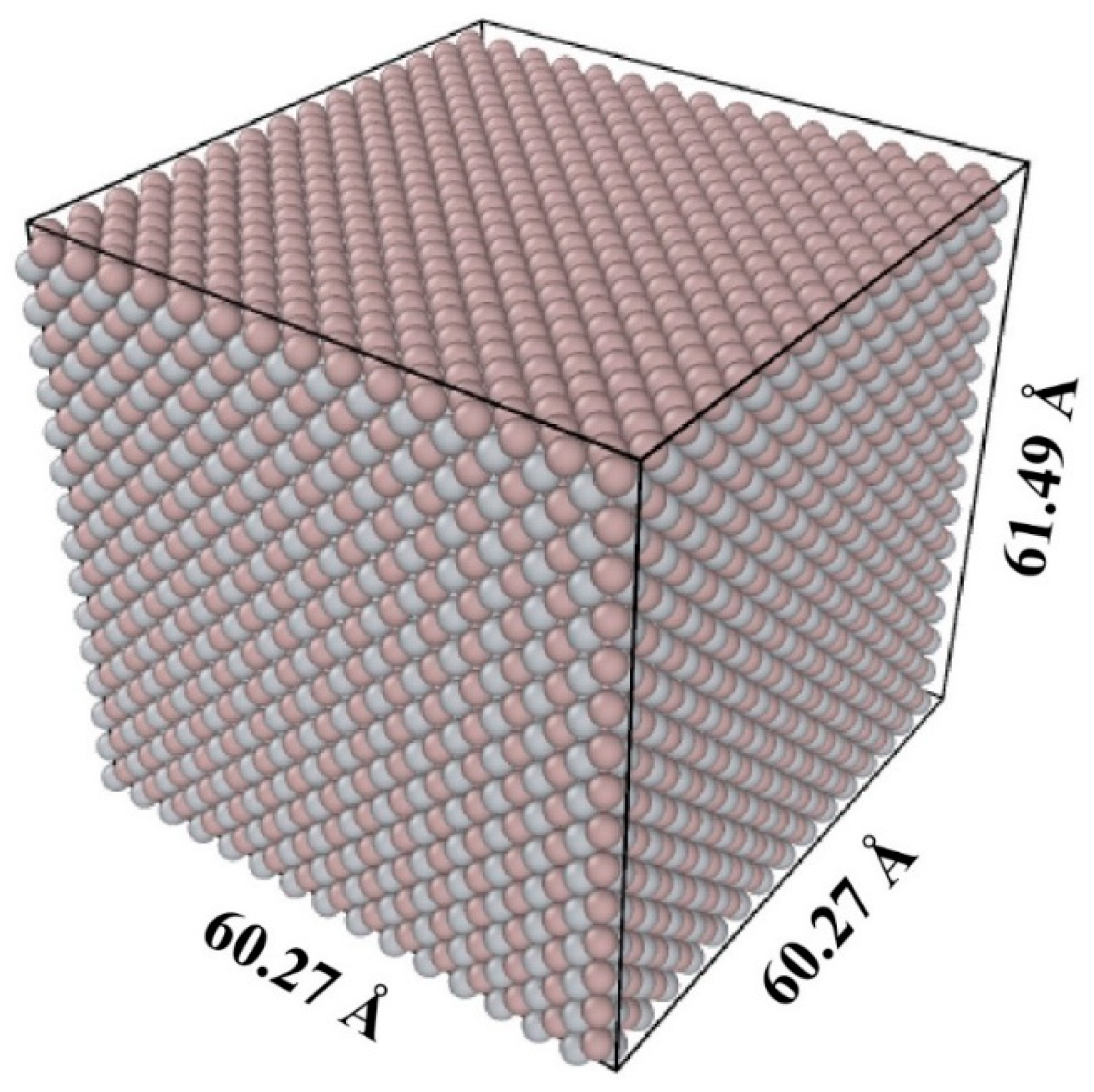
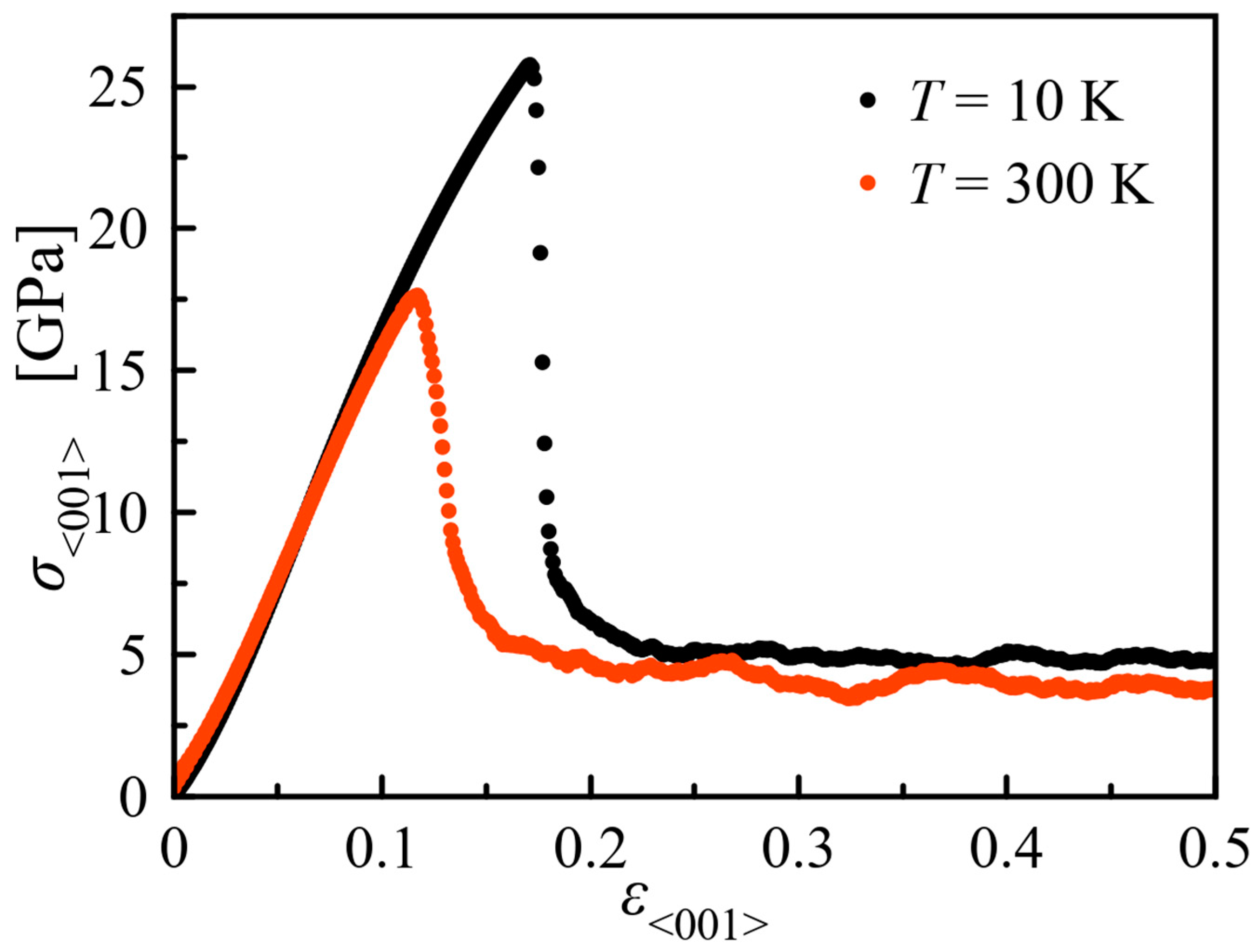



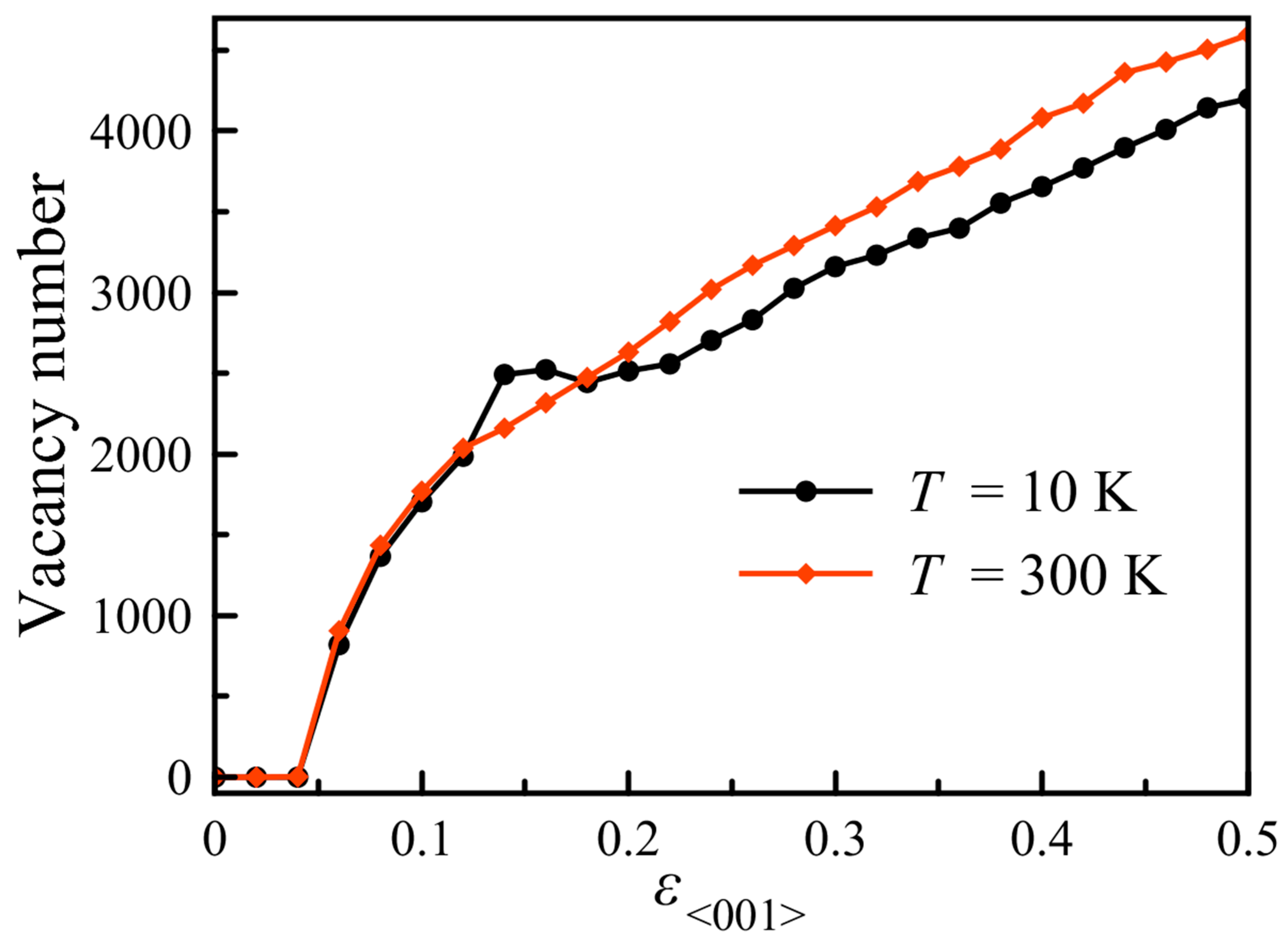
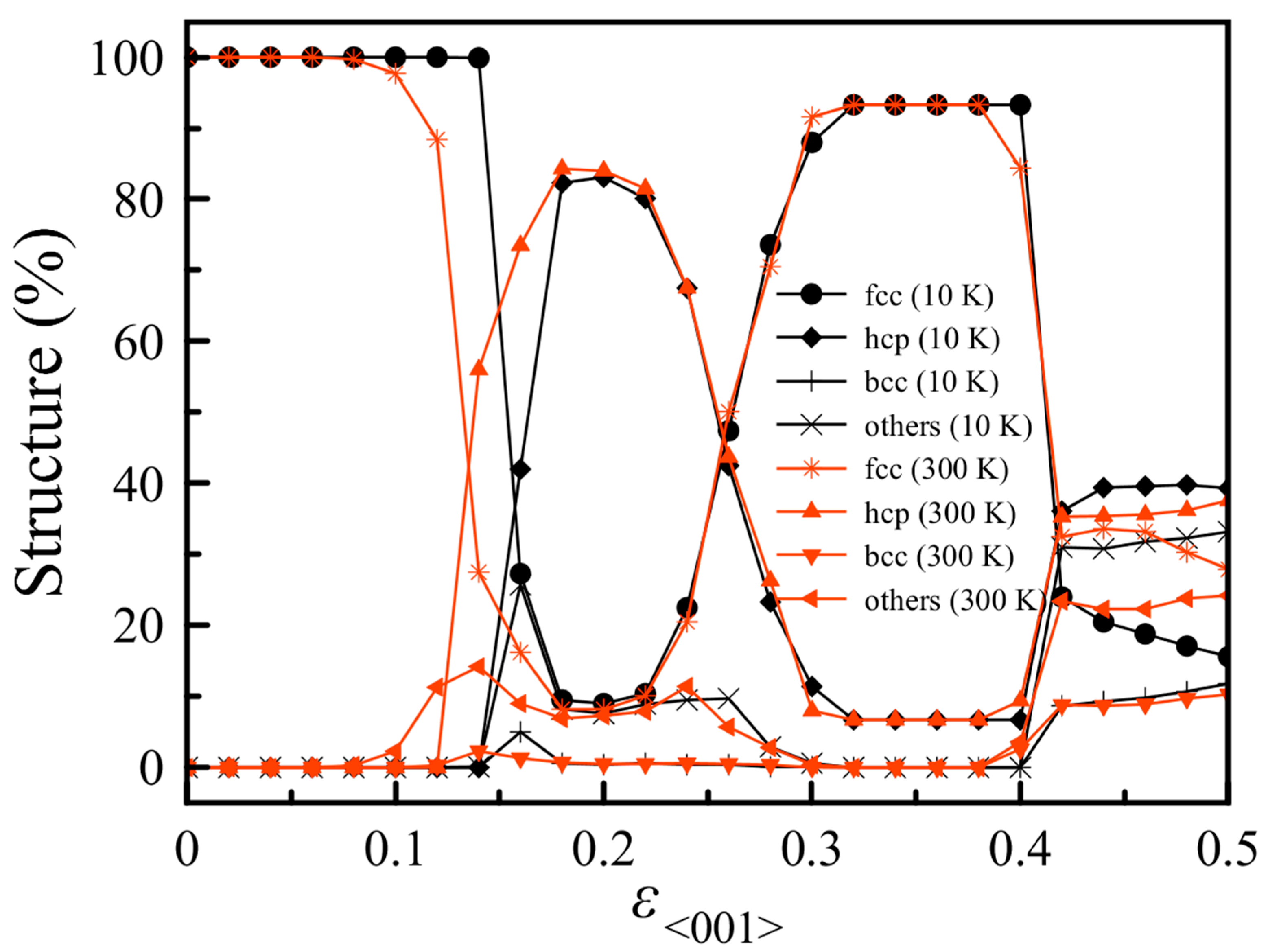
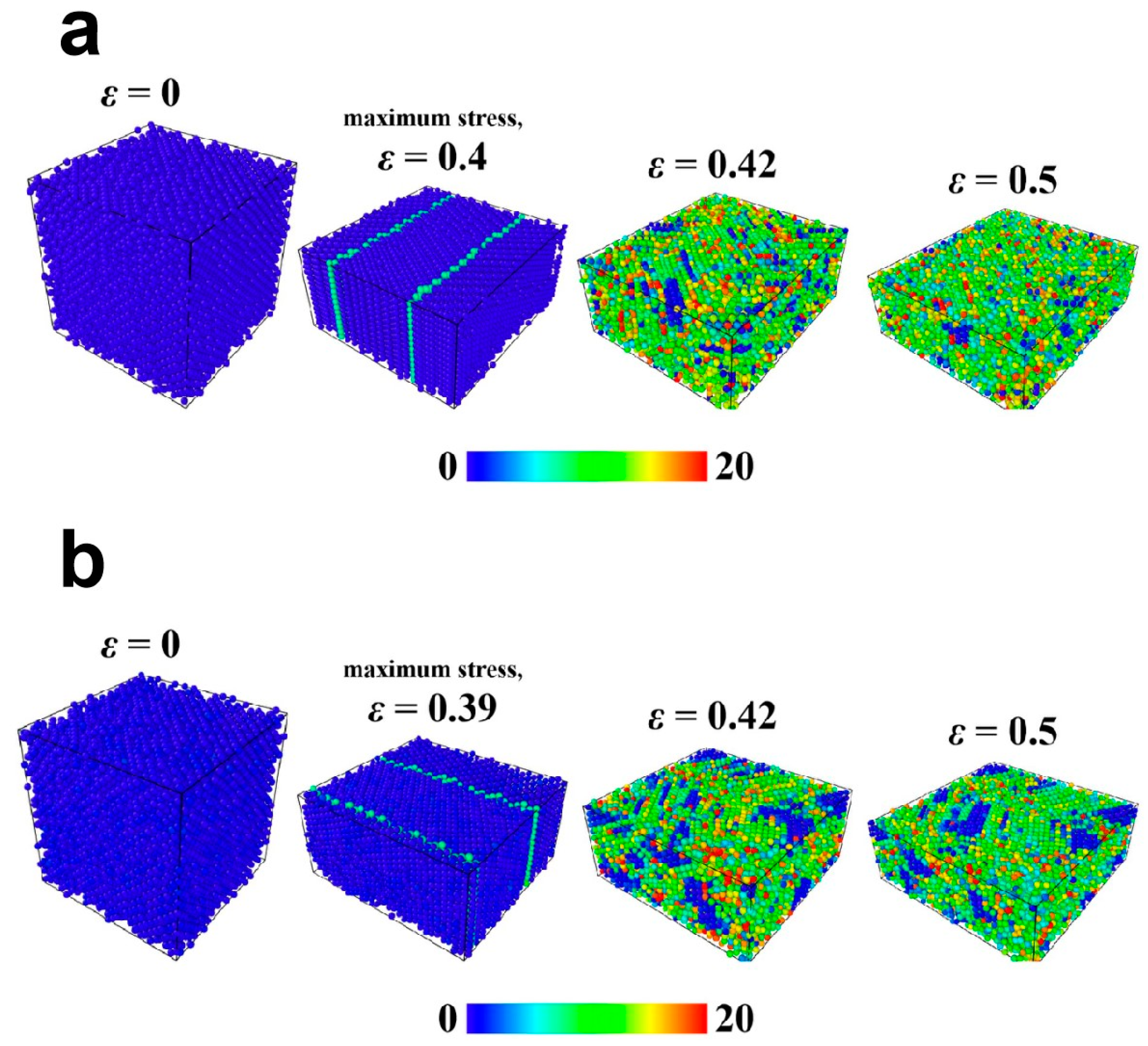
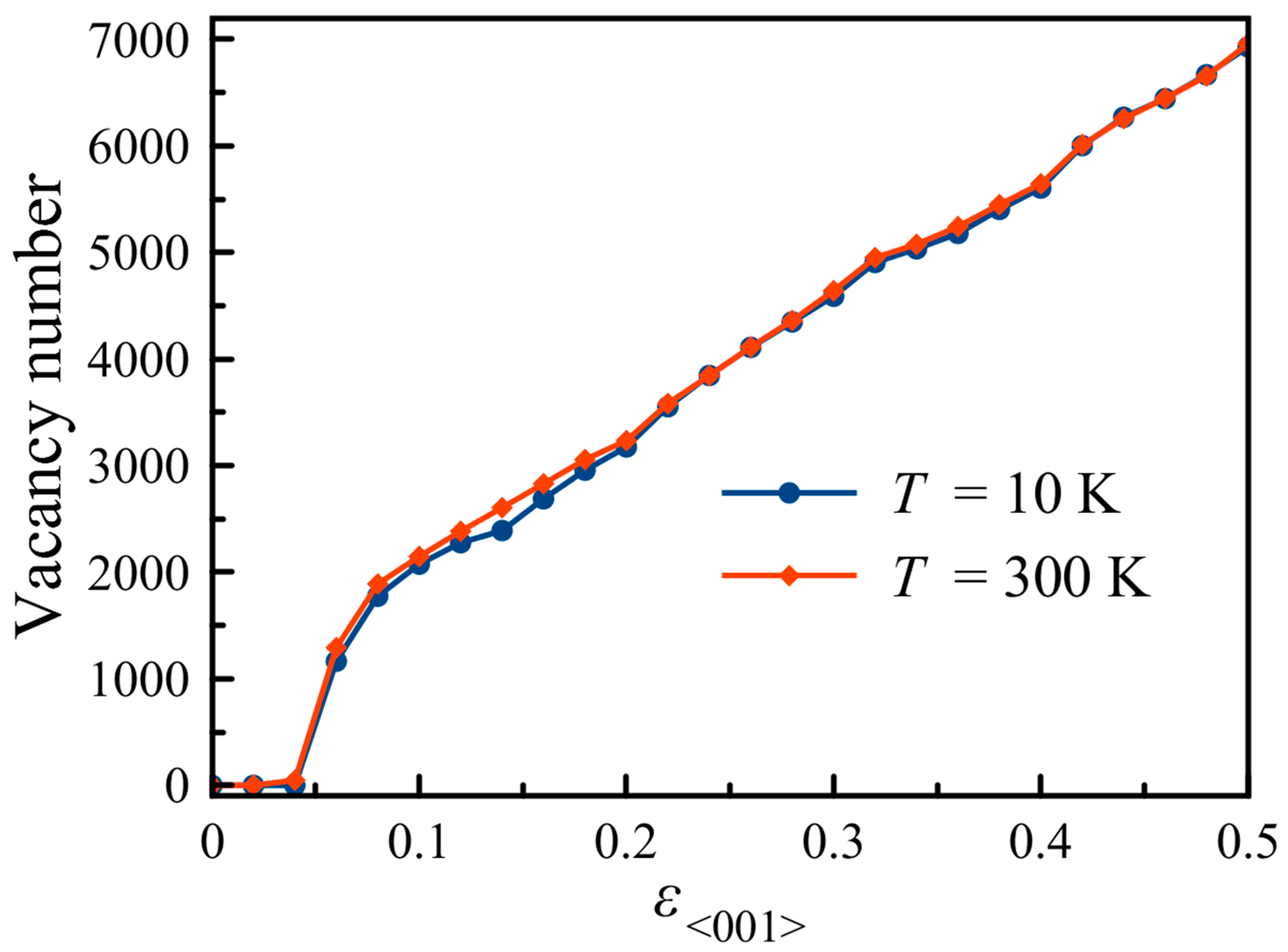
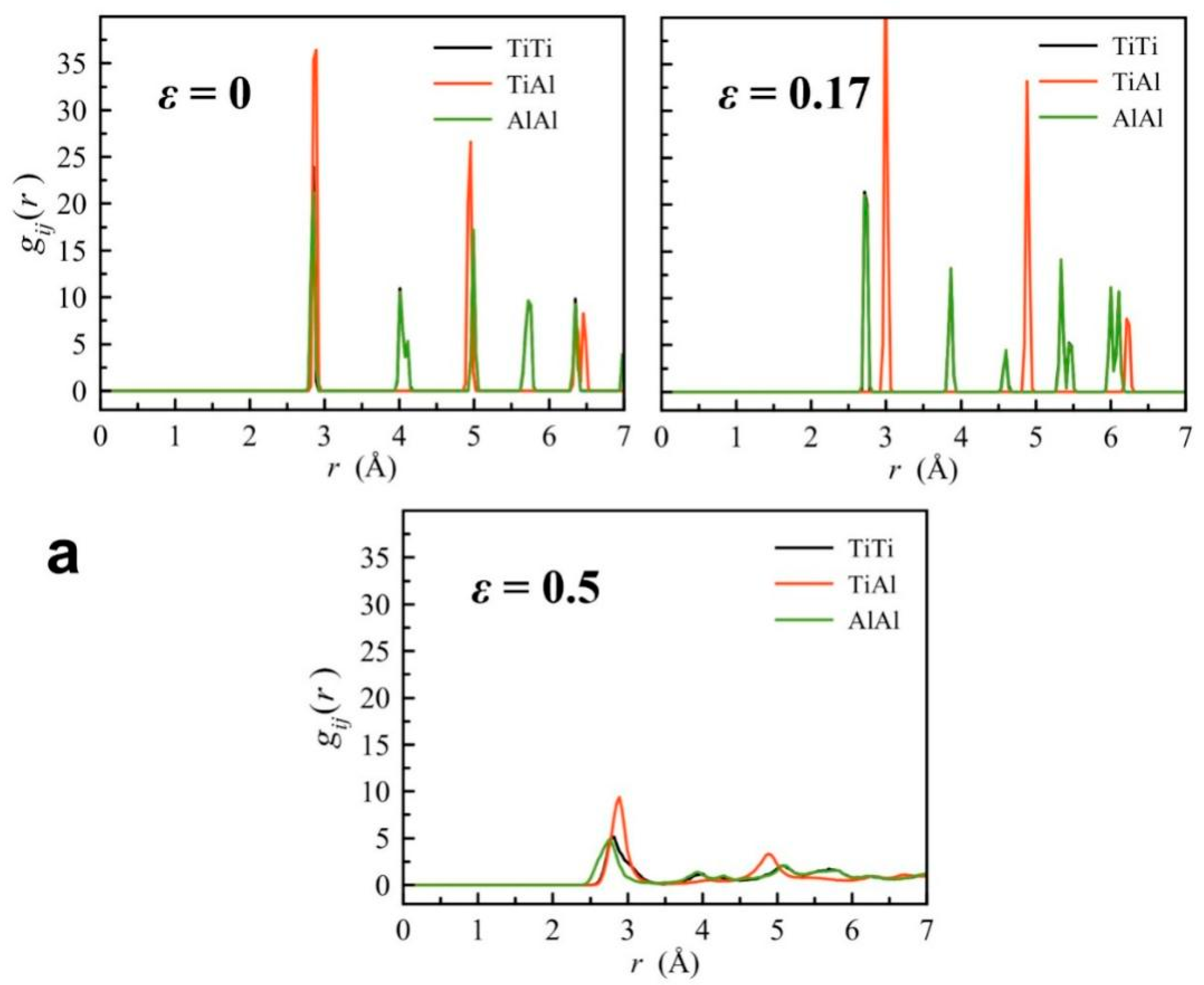
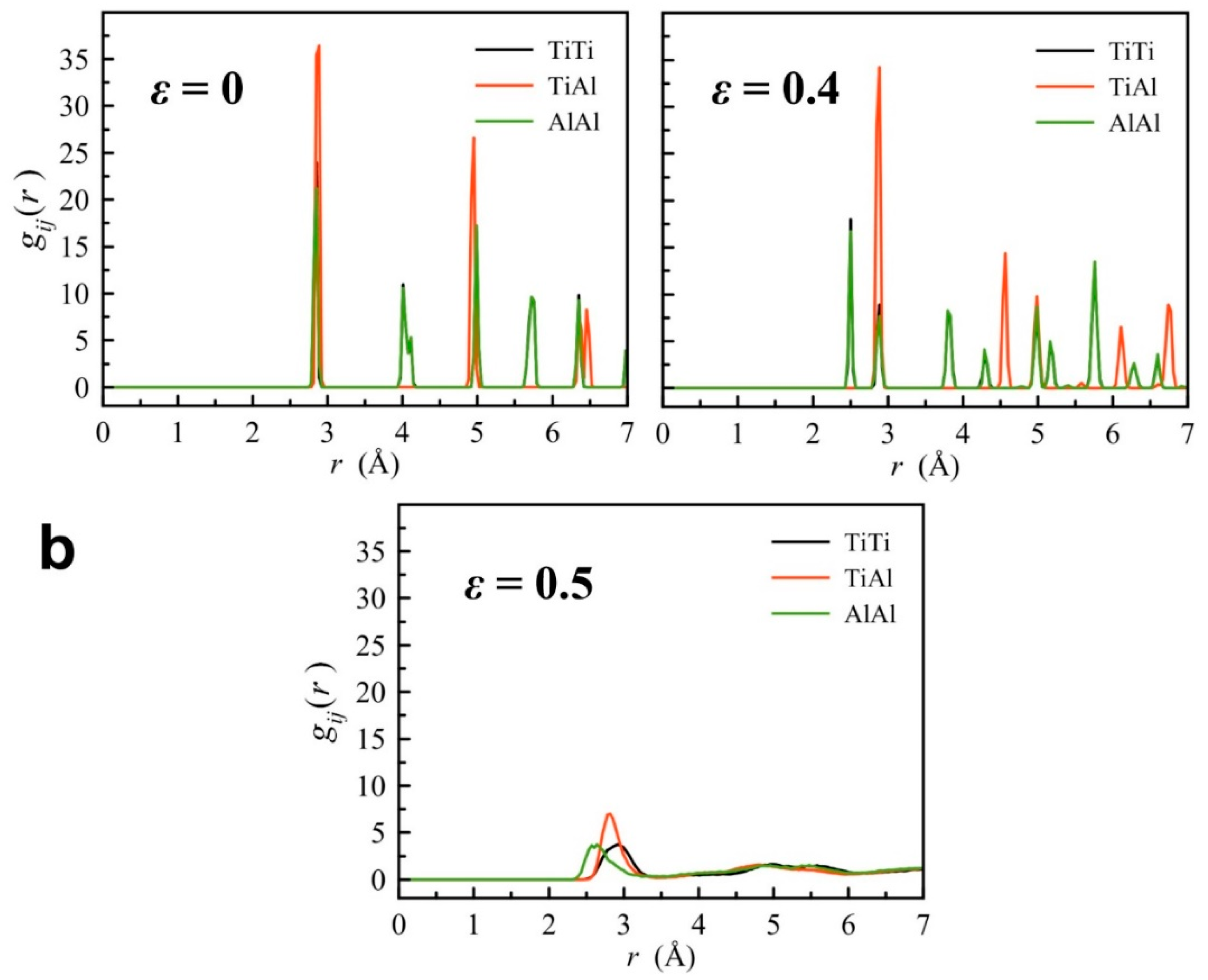
| Loading | T (K) | E (GPa) | σmax (GPa) |
|---|---|---|---|
| Tensile | 10 | 180.0 a; 182.0 b; 172.2 c | 25.8 a |
| 300 | 168.5 a; 178 b; 157.8 c | 17.7 a | |
| Compression | 10 | 145.9 a | 39.2 a |
| 300 | 89.2 a | 31.3 a |
Publisher’s Note: MDPI stays neutral with regard to jurisdictional claims in published maps and institutional affiliations. |
© 2021 by the authors. Licensee MDPI, Basel, Switzerland. This article is an open access article distributed under the terms and conditions of the Creative Commons Attribution (CC BY) license (https://creativecommons.org/licenses/by/4.0/).
Share and Cite
Arifin, R.; Astuti, F.; Baqiya, M.A.; Winardi, Y.; Wicaksono, Y.A.; Darminto; Selamat, A. Structural Change of TiAl Alloy under Uniaxial Tension and Compression in the <001> Direction: A Molecular Dynamics Study. Metals 2021, 11, 1760. https://doi.org/10.3390/met11111760
Arifin R, Astuti F, Baqiya MA, Winardi Y, Wicaksono YA, Darminto, Selamat A. Structural Change of TiAl Alloy under Uniaxial Tension and Compression in the <001> Direction: A Molecular Dynamics Study. Metals. 2021; 11(11):1760. https://doi.org/10.3390/met11111760
Chicago/Turabian StyleArifin, Rizal, Fahmi Astuti, Malik Anjelh Baqiya, Yoyok Winardi, Yoga Arob Wicaksono, Darminto, and Ali Selamat. 2021. "Structural Change of TiAl Alloy under Uniaxial Tension and Compression in the <001> Direction: A Molecular Dynamics Study" Metals 11, no. 11: 1760. https://doi.org/10.3390/met11111760
APA StyleArifin, R., Astuti, F., Baqiya, M. A., Winardi, Y., Wicaksono, Y. A., Darminto, & Selamat, A. (2021). Structural Change of TiAl Alloy under Uniaxial Tension and Compression in the <001> Direction: A Molecular Dynamics Study. Metals, 11(11), 1760. https://doi.org/10.3390/met11111760








